Sulu: The islands that are home to Philippine militancy
- Published
Watch the BBC's Kate McGeown visit the islands
The islands of Sulu, in the south-west Philippines, look like the type of tropical paradise you would see on the front cover of a tourist brochure.
But appearances can be deceptive. This is a violent and unstable region - a breeding ground for international terrorism.
That is why US troops arrived here shortly after the 9/11 attacks in New York and Washington.
"All the attacks that occurred between 1994 and 2001 at least touched, in some part, the southern Philippines," said Col Mark Miller, commander of the US Task Force here.
The region was used "either as a safe haven, or to conduct planning, or training, of the individual concerned," he said.
The Americans' mission here is part of the War on Terror; their mandate to advise their Philippine counterparts on strategy and tactics to win the fight against the different Islamic rebel groups that plague these islands.
It may be less well known than missions in Iraq and Afghanistan, but it ignites the same divided passions and still, more than 10 years later, shows no sign of coming to an end.
Business harmed
A quick look at the roll call of militants who have passed through these islands shows clearly why the Americans are here.
Khalid Sheikh Mohammed, the architect of the 9/11 attacks; Ramzi Yousef, accused of a pivotal role in the World Trade Centre bombings in the 1990s; Dulmatin, a key figure behind the Bali attacks - all of them spent time in the Philippines.
They were sheltered by the Abu Sayyaf, a home-grown insurgent group that claims it is fighting for an Islamic state but in reality is more of a kidnap-for-ransom gang.
It released two Filipino hostages earlier this month, but is still thought to be holding six foreigners - two Europeans, an Australian, a Malaysian, a Japanese and a Jordanian.
The Abu Sayyaf is a shadowy organisation, difficult to track, and with substantial support among local Muslim communities.
And it is not the only rebel group on these islands. Other Philippine groups, the Moro National Liberation Front (MNLF) and the Moro Islamic Liberation Front (MILF), are active in the area. These two groups have agreed peace deals with the government, but that does not mean they are no longer a fighting force. Just this week clashes between the MNLF and Abu Sayyaf left about 30 people dead.

Then there are the militants who arrived across the porous sea borders from Malaysia and Indonesia - members of the regional group Jemaah Islamiah, which has known links to al-Qaeda.
For ordinary residents of Sulu, like 16-year-old Lovell Lauzon, everyday life is punctuated by the knowledge that somewhere nearby, violent extremists are living and possibly planning their next move.
"Fear hinders you from doing what you want. It limits you," she said.
"Even if you want to go to places - the beaches, the forests - because of those threats, you are afraid."
Fear also hinders business, growth and development. The Autonomous Region of Muslim Mindanao, which includes Sulu, is the poorest region in the Philippines.
It has the highest levels of infant mortality, the lowest levels of adult literacy, and the big chain stores and shopping malls seen in other parts of the country are largely absent.
Caught in crossfire
Despite fighting numerous rebel groups across numerous islands, the Philippine military gradually seem to be gaining ground, no doubt helped by the training they have received from the Americans.
Colonel Mark Miller: 'Another rebel group could fill the void left if Abu Sayyaf is defeated'
The militants occupy just a third of the area they once did.
But the battle against the insurgents is not just about gaining territory - it is also about gaining the trust of the locals.
Some Filipinos - and not just those in Sulu - are uneasy about the US presence in the southern Philippines, questioning its necessity and even claiming it is a retrograde step, back to the US colonial past.
And to the average Sulu resident, members of the Philippine military are almost as foreign as the Americans, as most of them are non-Muslims from elsewhere in the country.
Civilians caught in the crossfire, heavy-handed tactics, and the fact that many people have relatives in one or more of the rebel groups, all contribute to this sense of mistrust.
And if the locals do not trust the security forces above the rebels, the rebels will never be defeated.
That is why the US military is moving its focus away from military tactics and onto efforts to engage the local community.
Together with their Philippine counterparts, they hold events to provide free healthcare and food, and foster initiatives to promote peace.
"Our objective is to start the healing process. We want to build trust again," said the commander of the local marines, Col Orlando de Leon.
He is extremely optimistic about the progress being made, and is already looking ahead to a time in which tourists and investors flock to Sulu.

US training is helping local troops to gain ground against the militants
He showed me promotional material filled with images of tropical beaches, stunning sunsets and exotic birds.
But all that is optimistic yet. The last foreign birdwatchers known to have visited the region - two men from the Netherlands and Switzerland - are among Abu Sayyaf's current hostages.
And as Col Miller said: "Even if the Philippine military is successful in rounding up all the terrorists… there's still the base conditions that need to be addressed."
"Because if not, in one, two, three years, there'll be another group with another name that will be down here."
Progress is definitely being made, but right now, the islands of Sulu are still as dangerous as they are beautiful.
- Published3 February 2013
- Published18 October 2012
- Published2 February 2012
- Published5 May 2012
- Published8 October 2012